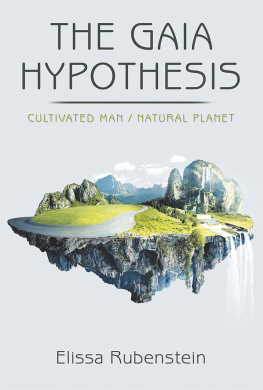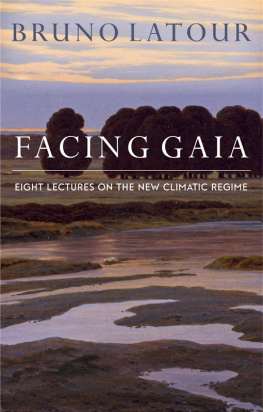I am truly grateful to Richard Betts, John Gray, Armand Neukermans, Sir Crispin Tickell, Brian Foulger, Gari Owen, Tim Donaldson and Elaine Steel, who read the book and made helpful comments, and to Chris Rapley, Stephan Harding, Peter Liss, Andrew Watson, Tim Lenton and Dave Wilkinson for their valued advice. I also thank GAIA, registered charity no. 327903, for support during the writing of this book.
Foreword
by Martin Rees
A little more than forty years ago, the Apollo 8 astronauts, while orbiting the Moon, photographed the whole Earth its biosphere contrasting with the sterile moonscape where the astronauts left their footprints. The Apollo images raised global awareness that Spaceship Earth was vulnerable, and that sustaining it was an ecological imperative. But there was a second important influence with similar global resonance not an image, but an arresting and romantically titled new concept. This was Gaia the idea that the Earths biosphere behaves as though it were a single organism.
Gaia was the insight of a man who is undoubtedly one of the most original and influential living scientists: James Lovelock. He believes that our species is now putting the Earth under unprecedented stress, and that climate change could lead to a world with much impoverished ecology that is barely habitable by humans. More scarily (and more controversially) he claims that the point of no return may already have been passed.
Our planet is nearly 4.5 billion years old. If some aliens had been watching it from afar ever since its birth, what would they have seen? Over nearly all that immense time changes were incessant, but generally gradual. The continents drifted; the ice cover waxed and waned; global temperatures rose and fell; species emerged, evolved and became extinct.
But in just a tiny sliver of the Earths history the last one millionth part, a few thousand years the patterns of vegetation altered much faster than before. This signalled the start of agriculture. The pace of change accelerated as human populations rose and engaged in urban and industrial activity. Consumption of fossil fuels caused an anomalously fast buildup of carbon dioxide in the atmosphere; the climate changed, and the world started to heat up.
If they understood astrophysics, the aliens watching our planet could confidently predict that the biosphere would face doom when the Sun brightens, and eventually flares up into a red giant star. But could they have forseen this unprecedented sudden fever less than half way through the Earths life these humaninduced changes, seemingly occurring with runaway speed?
And what might these hypothetical aliens witness in the next hundred years? Will spasms be followed by stability? If so, will our Earth settle into a state that still offers a habitat for humans? Or have our unplanned interventions irrevocably tipped the planet into a new and far hotter climatic state? If so, how many present species of animals and plants will survive?
These issues climate change and loss of biodiversity have risen high on the international agenda. James Lovelock is helping to keep them there. He is a hero to many scientists certainly to me. His individualistic career is a welcome counterpoint to the specialized, quasiindustrial style in which most research is conducted. In the 1960s he designed an instrument that was so sensitive at detecting minute traces of atmospheric pollutants that many colleagues refused to believe his claims. He is beholden to no institution. He ranges freely across the disciplinary boundaries that too often constrain institutional thinkers.
The flavour of James Lovelocks mind and personality shine through in this important and highly readable book. He writes clearly even entertainingly with many apt analogies. But he writes also with passion; and his thoughts are grounded in a lifetime of distinguished work. He is both a fine scientist and an eloquent advocate of action.
Many of us still hope that our civilization can segue towards a lowcarbon future and a lower population and achieve this transition without trauma and disaster. But that benign outcome demands determined action by governments, urgently implemented; and such urgency wont be achieved unless sustained campaigning can transform public attitudes and lifestyles. Programmes to develop clean energy must be accorded, worldwide, the urgency that the US gave to the Apollo programme in the 1960s.
Those of us who are scientists should aspire to emulate James Lovelocks inventiveness; all citizens should be inspired by his commitment and altruism. It is no exaggeration to say that our civilizations longterm future depends on whether the call to arms in this riveting book is widely heeded.
Martin Rees
Trinity College, Cambridge
January 2009
The Journey in Space and Time
Icons are important to us: the cross and the scimitar have dominated lives and history for two millennia. For some the icon of greatest meaning is that bluewhite vision of the Earth first seen from space by astronauts. That icon is undergoing subtle change as the white ice fades away, the green of forest and grassland fades into the dun of desert, and the oceans lose their bluegreen hue and turn a purer, swimmingpool blue as they too become desert. This is why at ninety years old I will try to emulate the astronauts and fly into space to see the Earth from above before it vanishes. I want to catch a glimpse of the Earth I have lived with all my life, even though my most trusted physician, Douglas Chamberlain, has advised me that the risk is too high. I will go, despite the warnings, to recapture that enthralling eureka moment fortyfour years ago when I was working at the then centre of space research, the Jet Propulsion Laboratory (JPL) in California and saw with my minds eye our planet as something possibly unique in the universe, something alive. Since then I have thought of the word Earth as inadequate to describe the living planet that we inhabit and are a part of. I am grateful to the author William Golding for his suggestion that the name Gaia was more appropriate. Not least among the joys of seeing our live planet from high above will be the simple pleasure of seeing with my own eyes how spherical it is. I had few doubts that this was so but as with many things in life as well as in science, we have to take for granted that it is round, even though when on the ground, our eyes tell us it is flat.








